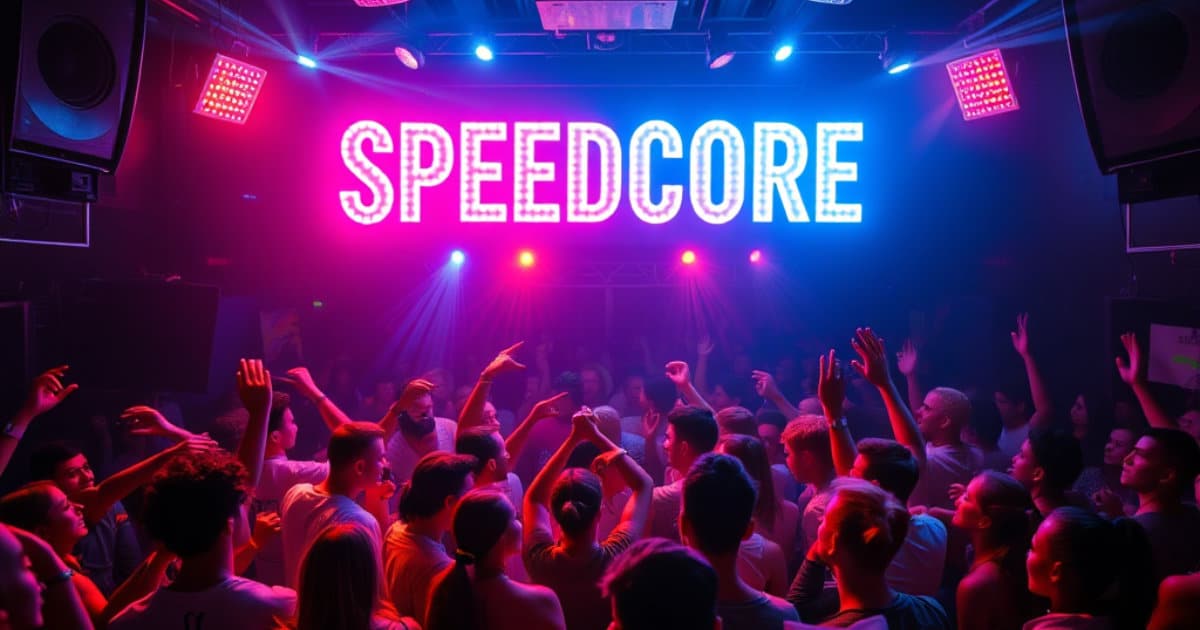Estimated reading time: 13 minutes
Brace yourself for a sonic assault!
Ever felt like your music just wasn’t fast enough? Enter the world of speedcore, where beats per minute are cranked up to dizzying heights and conventional musical norms are shattered. This intense, high-octane genre pushes the boundaries of what’s possible in electronic music, leaving listeners exhilarated and breathless.
But what exactly is speedcore? How did this extreme subgenre evolve, and why does it continue to captivate a dedicated fanbase? From its humble beginnings in early fast hardcore to its explosive peak and recent resurgence, the journey of speedcore is as fascinating as the music itself. Let’s dive into the heart-pounding history of this relentless genre, exploring its various sub-genres, influential periods, and the passionate community that keeps it alive.
Table of contents
Speedcore: MY Definition
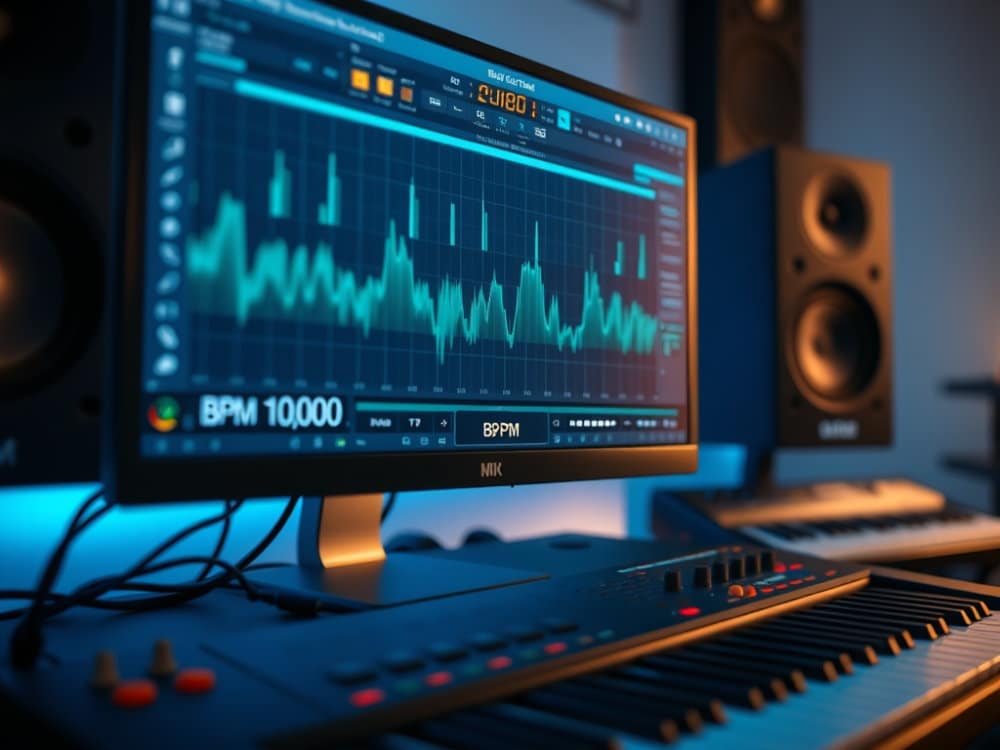
A. Defining Speedcore
Speedcore is an extreme subgenre of electronic music that pushes the boundaries of tempo and intensity. Characterized by its incredibly fast beats per minute (BPM), typically ranging from 300 to over 1000 BPM, speedcore takes hardcore techno to its logical extreme. The genre is known for its aggressive, distorted kick drums, harsh noise elements, and often dark or chaotic atmospheres.
Key elements of speedcore include:
- Ultra-fast tempos
- Distorted, heavily processed kick drums
- Intense, abrasive sound design
- Minimal melodic elements
- Frequent use of samples from industrial and metal genres
| Aspect | Hardcore Techno | Speedcore |
|---|---|---|
| Tempo | 150-200 BPM | 300+ BPM |
| Kick | Hard, distorted | Extremely distorted, often pitch-shifted |
| Melody | Present | Minimal or absent |
| Atmosphere | Energetic | Chaotic, aggressive |
B. About the Name
The term “speedcore” is a combination of two words: “speed” and “hardcore.” This name perfectly encapsulates the essence of the genre:
- “Speed” refers to the extreme tempo that defines the music
- Hardcore” connects it to its roots in hardcore techno and gabber
The name “speedcore” emerged in the mid-1990s as producers began pushing hardcore techno to faster and more intense extremes. It quickly became the accepted term for this new, hyper-fast style of electronic music, distinguishing it from its slower predecessors.
Speedcore sub-Genres
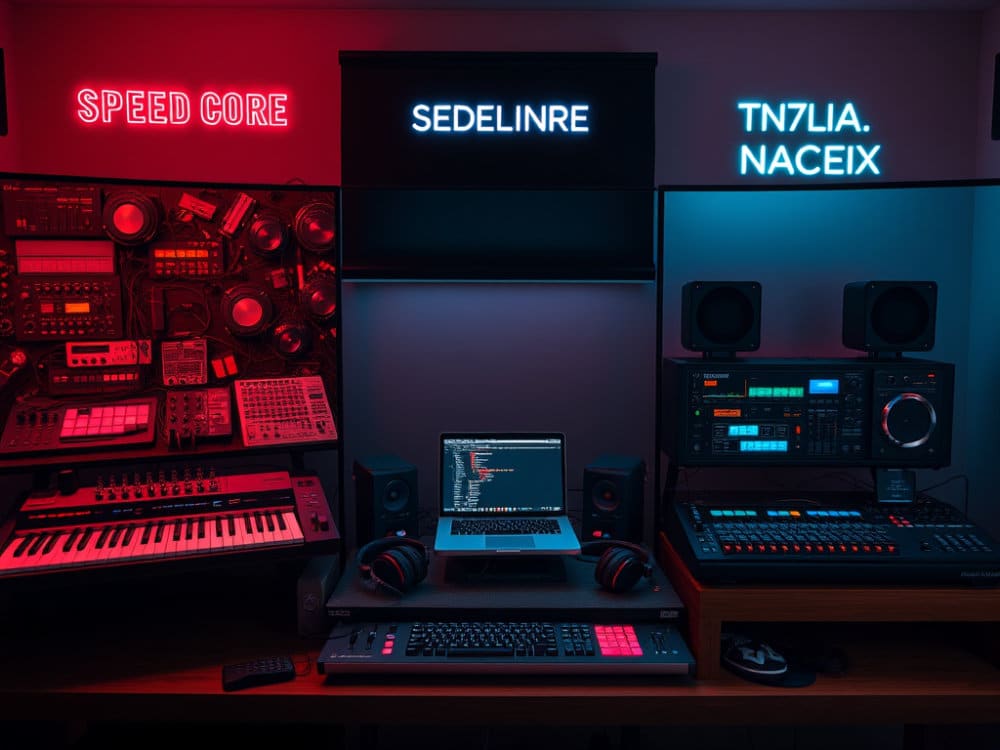
A. J-Core
J-Core is a unique fusion of Japanese pop culture and hardcore electronic music. This subgenre of speedcore incorporates elements of anime, video game soundtracks, and J-pop, creating a distinctive sound that appeals to both hardcore music enthusiasts and anime fans.
Key characteristics of J-Core:
- Fast-paced beats (typically 180-300 BPM)
- Melodic synth lines inspired by anime and video game music
- Vocals often sampled from anime or featuring Japanese lyrics
- Bright, energetic atmosphere
| Feature | J-Core | Traditional Speedcore |
|---|---|---|
| Tempo | 180-300 BPM | 300+ BPM |
| Mood | Upbeat, melodic | Aggressive, dark |
| Influences | Anime, J-pop, video games | Industrial, noise |
| Vocals | Japanese lyrics, anime samples | Minimal or distorted |
B. Dark Melodic Speedcore
Dark Melodic Speedcore combines the intense speed of traditional speedcore with haunting melodies and atmospheric elements. This subgenre creates a unique juxtaposition between extreme tempo and emotional depth.
C. FlashCore
FlashCore takes speedcore to its limits, pushing tempos to extreme levels. This subgenre is characterized by:
- Ultra-fast tempos (500+ BPM)
- Minimal melodic elements
- Focus on rhythmic complexity
- Often incorporates glitch-like effects
D. Other Genres faster Speedcore
While speedcore itself is known for its extreme tempos, there are even faster subgenres pushing the boundaries of electronic music:
- Extratone: Features tempos of 1000+ BPM
- Noisegrind: Combines elements of noise music and grindcore
- Splittercore: Emphasizes rhythmic complexity at high speeds
These subgenres showcase the ongoing evolution of extreme electronic music, constantly pushing the limits of speed and sonic intensity.
Early fast hardcore (pre 1995)
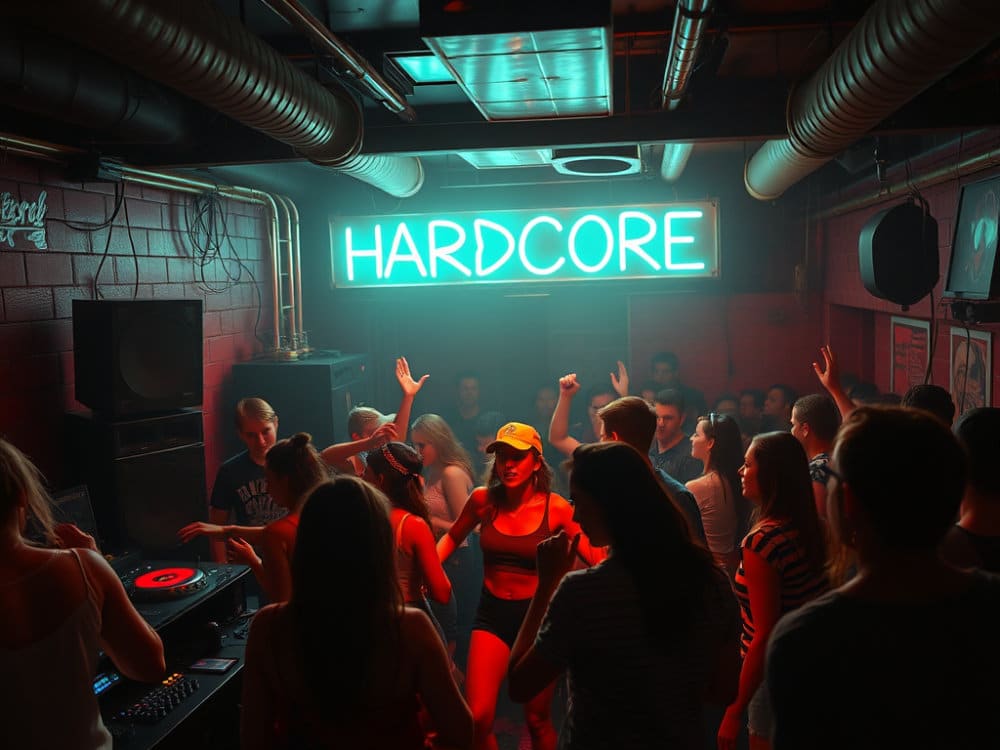
A. 1992
In 1992, the seeds of what would later become speedcore were beginning to sprout. This year marked a significant shift in the hardcore techno scene, with producers pushing the boundaries of tempo and aggression. Notable releases from this year included:
| Artist | Track | BPM |
|---|---|---|
| The Prophet | Allright Now | 180 |
| Mescalinum United | We Have Arrived | 200 |
| T99 | Anasthasia | 160 |
These tracks, while not yet reaching the extreme speeds of later speedcore, laid the groundwork for the genre’s evolution. Producers began experimenting with faster tempos, distorted kick drums, and more aggressive synthesizer sounds.
B. 1993
1993 saw a further acceleration in hardcore techno, with more artists embracing higher BPMs and harsher sounds. Key developments included:
- Introduction of pitch-shifted vocals
- Increased use of distorted bass drums
- Emergence of the “gabber” sound in Rotterdam
Influential releases from this year:
- Neophyte – Hardcore Muthaf*cka
- Rotterdam Termination Source – Poing
- Lenny Dee – Fucking Hostile
These tracks pushed the tempo even further, often exceeding 200 BPM, and introduced elements that would become staples of speedcore.
C. 1994
By 1994, the foundations of speedcore were firmly in place. This year saw:
- Tempos regularly exceeding 220 BPM
- Increased focus on distorted, industrial-like sounds
- Emergence of more extreme subgenres
Notable releases included:
| Artist | Track | BPM |
|---|---|---|
| Chosen Few | Name of the DJ | 230 |
| DJ Skinhead | Extreme Terror | 240 |
| Neophyte | Execute | 225 |
These tracks showcased the rapid evolution of hardcore techno into what would soon be recognized as speedcore. The genre’s signature elements – extreme tempos, distorted kicks, and aggressive synth lines – were now fully formed, setting the stage for the gabber explosion of the mid-90s.
Gabba Years (95- 98)
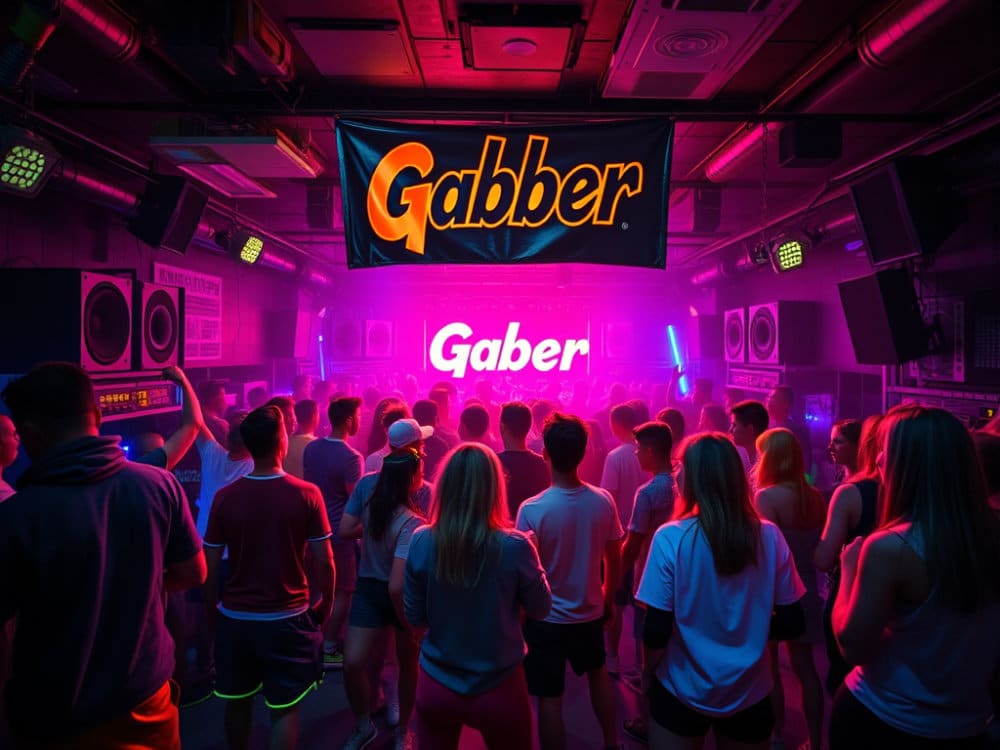
Gabba Years (95-98)
The Gabba Years marked a significant evolution in the speedcore genre, taking the already intense hardcore techno sound to new extremes. This period saw the emergence of iconic artists and labels that would shape the future of speedcore.
Key Characteristics
- Tempo: 180-250 BPM (and sometimes beyond)
- Sound: Distorted kicks, aggressive synths, and often industrial-inspired elements
- Attitude: Rebellious, underground, and unapologetically extreme
Notable Artists and Labels
| Artists | Labels |
|---|---|
| Lenny Dee | Industrial Strength Records |
| The Dreamteam | Rotterdam Records |
| The Speed Freak | Mokum Records |
| DJ Promo | Thunderdome |
Influence on Speedcore Development
The Gabba Years played a crucial role in pushing the boundaries of tempo and intensity in electronic music. This period laid the foundation for what would become modern speedcore, influencing future subgenres and artist approaches.
- Increased tempo: Tracks regularly surpassed 200 BPM
- Distortion techniques: Pioneered new ways to create harder, more aggressive sounds
- Cultural impact: Established a dedicated underground scene and fashion style
The Gabba Years set the stage for the next phase of speedcore’s evolution, paving the way for even more extreme and diverse interpretations of the genre in the years to come.
Speedcore youth (99-2003)

The Rise of Speedcore Youth
In the late 90s and early 2000s, speedcore experienced a significant transformation, driven by a new generation of producers and enthusiasts. This period, often referred to as the “Speedcore Youth” era, saw the genre evolve and expand in exciting ways.
Key Developments
- Technological Advancements: The accessibility of digital audio workstations (DAWs) revolutionized production techniques.
- Internet Communities: Online forums and file-sharing platforms facilitated global collaboration and genre exploration.
- Crossover Influences: Speedcore began to incorporate elements from other extreme genres like black metal and noise.
Notable Artists and Labels
| Artist | Label | Signature Style |
|---|---|---|
| Passenger of Shit | Self-released | Chaotic, sample-heavy |
| Gigabeat | Bloody Fist Records | Relentless, industrial-tinged |
| Rotator | Hangars Liquides | Experimental, glitch-infused |
Sound Evolution
- Increased BPM: Tracks regularly exceeded 300 BPM
- Distortion Experimentation: Producers pushed the limits of sound design
- Complex Rhythms: Incorporation of breakbeats and irregular time signatures
The Speedcore Youth era laid the groundwork for the genre’s explosive growth in the mid-2000s. As we explore the next phase, we’ll see how these innovations set the stage for speedcore’s wider recognition and diversification.
Speedcore “Explosion” (2005-2008)
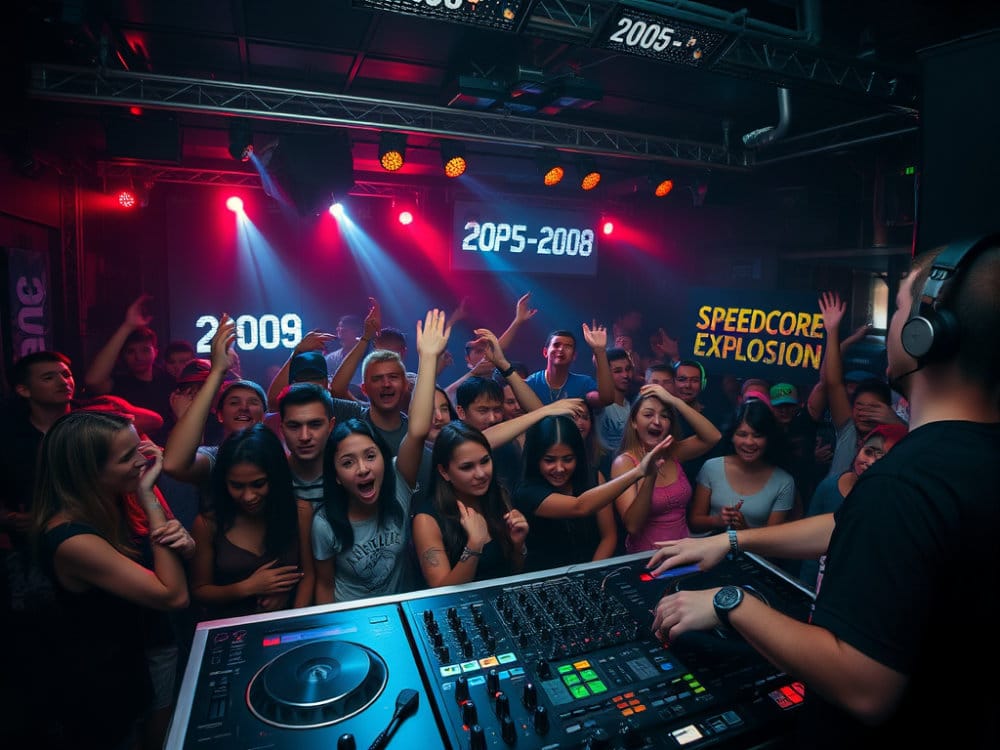
The Rise of Speedcore Labels
During the Speedcore “Explosion” of 2005-2008, numerous independent labels emerged, dedicated to pushing the boundaries of extreme electronic music. These labels played a crucial role in popularizing and diversifying the genre.
| Label Name | Country | Notable Artists |
|---|---|---|
| Speedcore Worldwide | Germany | DJ Mutante, Autopsy |
| Ketamin Records | France | Rotator, The Speed Freak |
| Industrial Strength | USA | Lenny Dee, The Sickest Squad |
| Drop Bass Network | USA | Delta 9, Noize Creator |
Technological Advancements
The mid-2000s saw significant improvements in music production software and hardware, enabling producers to create even faster and more complex tracks. This technological leap contributed to:
- Increased BPM ranges (often exceeding 300 BPM)
- More intricate sound design
- Enhanced audio quality in high-speed compositions
Global Recognition and Events
Speedcore gained international recognition during this period, with dedicated events popping up around the world:
- Speedfreak parties in Germany
- Hardcore Till I Die festivals in the Netherlands
- Thunderdome’s inclusion of speedcore acts
- Underground raves in Eastern Europe and Russia
These events helped solidify speedcore’s place in the extreme electronic music scene and fostered a sense of community among fans and producers alike.
Video: SPEEDCORE MIX 2022
The sleepy years
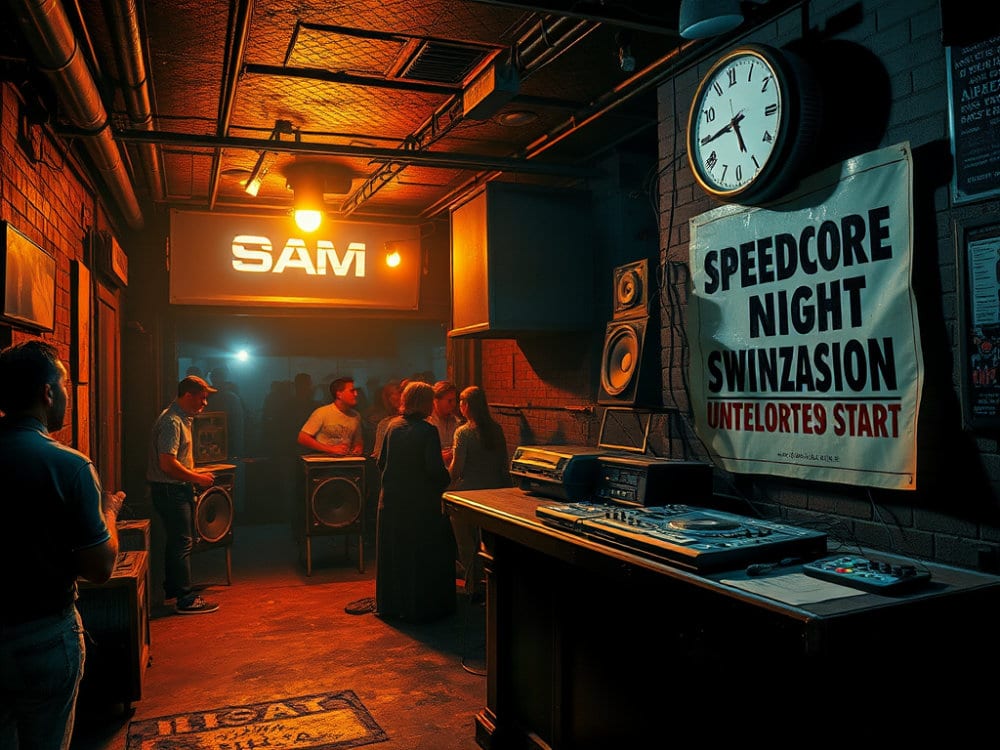
The Sleepy Years
After the explosive growth of speedcore between 2005 and 2008, the genre entered a period of relative quietude. This era, often referred to as “The Sleepy Years,” saw a decline in mainstream attention and production output. However, this doesn’t mean the genre disappeared entirely.
Factors Contributing to the Slowdown
Several factors contributed to the speedcore slowdown:
- Oversaturation of the market
- Shift in electronic music trends
- Burnout among producers and fans
- Limited innovation within the genre
Underground Persistence
Despite the apparent decline, speedcore continued to thrive in underground circles:
- Small, dedicated communities kept the genre alive
- Online forums and file-sharing platforms became crucial for distribution
- Niche labels continued to release speedcore tracks, albeit at a slower pace
Evolution During the Sleepy Years
During this period, speedcore underwent subtle changes:
| Aspect | Pre-Sleepy Years | During Sleepy Years |
|---|---|---|
| Tempo | Extremely fast (300+ BPM) | Even faster (400+ BPM) |
| Production | Often raw and distorted | More polished, complex arrangements |
| Themes | Aggressive, dark | Experimental, abstract |
| Distribution | Physical releases, events | Primarily digital, online communities |
While the sleepy years marked a slowdown for speedcore, they also allowed for introspection and refinement within the genre. This period of relative quiet set the stage for the potential comeback that would follow, as artists and fans alike rekindled their passion for the extreme sounds of speedcore.
The comeback? (2016 – ??)
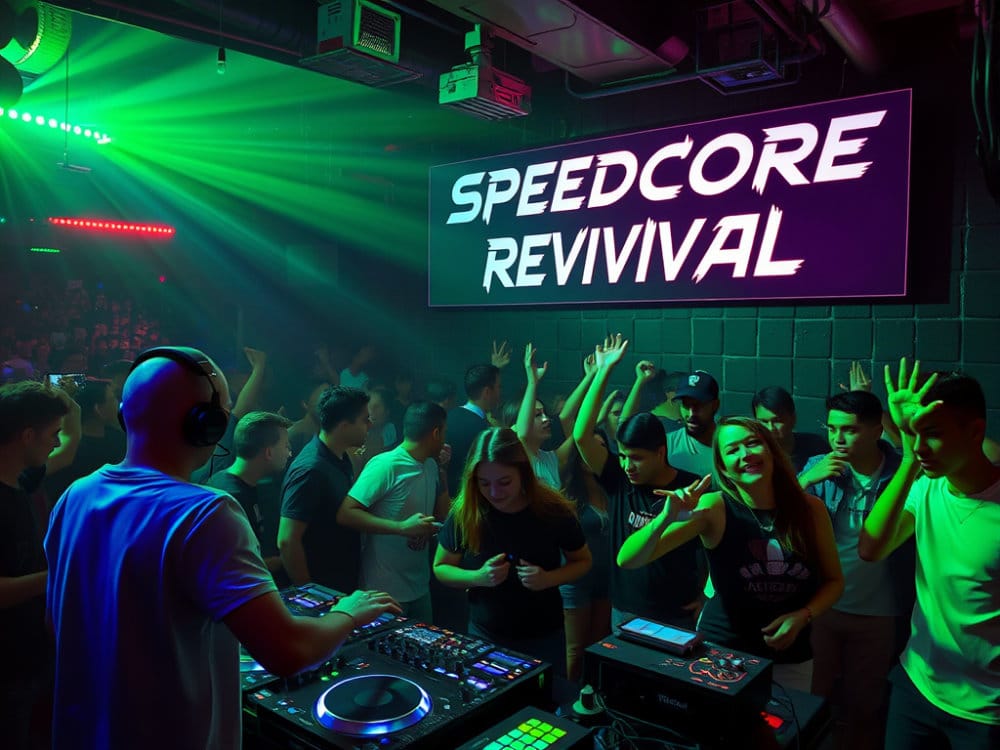
The comeback? (2016 – ??)
In recent years, speedcore has experienced a resurgence, breathing new life into the extreme electronic music genre. This revival can be attributed to several factors:
- Nostalgia from original fans
- A new generation discovering the genre
- Technological advancements in music production
- Increased accessibility through streaming platforms
The comeback of speedcore has been characterized by:
- Fusion with other genres
- Higher production quality
- More diverse and experimental sounds
- Increased presence at electronic music festivals
Table: Comparison of Original Speedcore vs. Modern Speedcore
| Aspect | Original Speedcore | Modern Speedcore |
|---|---|---|
| BPM | 300-1000 | 300-1000+ |
| Production | Lo-fi, raw | High-quality, polished |
| Themes | Dark, aggressive | Varied, including positive |
| Distribution | Vinyl, CDs | Digital, streaming |
| Community | Underground | Growing mainstream appeal |
As speedcore continues to evolve, it’s attracting both old-school enthusiasts and new listeners. The genre’s extreme nature and high-energy soundscapes are finding new audiences in the digital age, with social media and music streaming platforms playing a crucial role in its dissemination.

Speedcore, a high-octane subgenre of electronic music, has undergone a fascinating evolution since its inception. From its early roots in fast hardcore to the explosive years of the mid-2000s, this intense musical style has carved out a unique niche in the electronic music landscape. Through various sub-genres and distinct eras, speedcore has continually pushed the boundaries of tempo and intensity, captivating a dedicated fanbase along the way.
As we look to the future, speedcore’s potential comeback since 2016 hints at a renewed interest in this extreme form of music. Whether you’re a long-time fan or a curious newcomer, exploring the rich history and diverse sounds of speedcore offers an exhilarating journey into the fastest and most intense realms of electronic music. Dive in, discover its various incarnations, and experience the raw energy that defines this uncompromising genre.
Video: How to make Speedcore
Conclusion
In conclusion, speedcore remains one of the most extreme and exhilarating subgenres of electronic music. From its humble beginnings to its explosive peak and recent revival, it has continued to push the boundaries of tempo and intensity. Whether through its sub-genres or its underground persistence, speedcore offers a unique and powerful sonic experience for those seeking the fastest, most intense beats in the world of music. As the genre evolves, its passionate fanbase and ever-growing influence promise an exciting future for anyone ready to embrace its chaotic energy.
Related Posts
FAQs
Speedcore is an extreme subgenre of electronic music characterized by ultra-fast tempos, typically ranging from 300 to over 1000 BPM. It features distorted, aggressive kick drums, minimal melodies, and chaotic sound design, creating an intense listening experience that pushes the boundaries of electronic music.
Speedcore evolved from early fast hardcore techno in the early 90s, with producers increasing tempo and distortion. The genre exploded in the late 90s, gained international recognition in the mid-2000s, experienced a quieter period, and has recently made a comeback due to nostalgia and technological advancements.
Key sub-genres include J-Core, a fusion of anime and hardcore; Dark Melodic Speedcore, which blends fast tempos with atmospheric melodies; and FlashCore, pushing tempos beyond 500 BPM. Other extreme forms, like Extratone and Noisegrind, further expand speedcore’s boundaries with even faster tempos and harsher sounds.
Speedcore’s intensity comes from its lightning-fast tempos, extreme distortion, and chaotic sound design. The genre deliberately rejects conventional musical structure, opting for abrasive noise, rapid rhythms, and minimal melodies, creating a high-energy, unrelenting experience for both producers and listeners.
Yes, since 2016, speedcore has experienced a revival, driven by nostalgia, a new generation of listeners, and advancements in music production. This resurgence has brought higher production quality, a broader fanbase, and greater presence in electronic music festivals, ensuring the genre’s continued evolution and influence.
